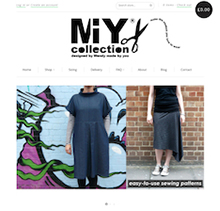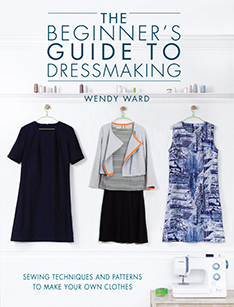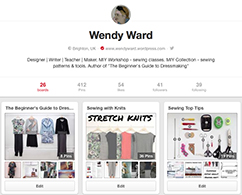My “Behind the Seams” column in this month’s Love Sewing magazine is all about what it’s like to write a sewing book! Here’s a longer version of the article along with interviews with some of the fabulous people I got to work with on the book.
My new book “A Beginner’s Guide to Making Skirts” is out next month and credit for this month’s column must go to editor Amy, who said to me a few months ago; “I hope you’ll be writing about what it’s like to write a sewing book for your column?” What a great idea, why didn’t I think of that?! I guess that’s why she’s the editor!
So, the whole thing began with an email from Cico when I came back from holiday last year. Once I’d written a detailed proposal for the book including a contents list, research about why the book should exist, who it was aimed at and some design ideas it was finally commissioned in October 2015. That might sound like a lot of work to do before I knew if the book would even be commissioned, but all that preparation and planning was invaluable – it was then full steam ahead and I had until early December to complete the first 3 projects.
Although most readers might think of the author as the main person in the production of a book, it’s the combined effort of a tight team of people. I think trust is one of the key elements in the production of a book, especially craft books that are so reliant on imagery. Soon after commissioning I went to meet with the Cico team where we discussed the overall look and style of the book. We all brought along ideas independently to illustrate how we envisioned the book would look and it was such a relief to see we were all on the same wavelength! As an author it’s incredibly important to me for my books to reflect my style and be identifiable as my work, but likewise it’s important for the publisher to produce a book that fits in with their look and style in a way that they think will sell.
Once an overall style had been agreed, the fun could begin and what always happens at the start of every dressmaking project……fabric shopping!
I am lucky to know some fabulous fabric people and bought most of the fabrics for my samples from Gill at Ditto and Fiona at Faberwood. The remainder consisted of some bits from my stash and I was also super-excited to work with my good friend Ce of The Uncommon Thread on some experiments in hand dyeing fabric, meaning there are some really unique samples in this book.
Then began the sampling, those wonderful hours spent in MIY Workshop on my own listening to the radio, drafting patterns and cutting up fabric to turn my designs into reality. There are 8 projects in the book each with 3 variations – that’s 24 skirts I needed to make, not including the rough initial toiles I made to check and tweak my patterns.
While doing this I was writing the step-by-step instructions at the same time. That’s always how I work, I like to make notes right then and there while I’m sewing. I’ve found that way I remember the little quirks and the things that might catch people out. All the time I’m approaching my making with the mindset of “What’s the best way to explain this? What are the things about this that someone without much experience will find difficult?” That’s when I’m really drawing on all of my teaching experience. As far as I’m concerned it’s the single best tool for writing clear instructions. If you haven’t witnessed a complete beginner hopelessly muddled by a pattern they can’t figure out, then you’re going to struggle to imagine yourself in their shoes when you’re writing instructions that you want them to be able to follow.
Next came the photoshoots, 3 of them, one in December, one in March and the last in April. I made 9 samples for each of the first 2 shoots and 6 for the last one. Part of the joy of photoshoots is working with other creative professionals. They’re long tiring days and so much easier if you’re all on the same wavelength and can work well together. Lucky for me I had a wonderful team; 2 great models in Lucy and Rachel, a fabulous (and hilarious) stylist in Rob, Julian the talented photographer who also shot my first book and Anna my editor from Cico who did a great job of looking after us all. Sadly my dogs didn’t get their mutts into this book as we shot in studios in London.
 Photoshoot dreamteam L to R: Julian (photographer), Anna (editor), me, Rob (stylist).
Photoshoot dreamteam L to R: Julian (photographer), Anna (editor), me, Rob (stylist).
Once the projects were finished and photographed, the techniques section of the book needed to be written up and illustrated. As well as the text I also did all the diagrams for this book.
I wrote over 20,000 words and drew over 300 illustrations, at the same time I had also been checking the editing of the project instructions. Editors who work on craft books have to be such sticklers for detail, I love working with people like that, who just won’t let the slightest little thing get past them. Sarah, my editor for this book was just that and although we never met, I feel like I know her well from the many conversations we’ve had about seemingly small details at odd hours of the day and evening (one of which was the day before Christmas Eve). Yep, dedication, that’s what you need!
I love the creative process of designing new patterns and making samples. I even enjoy the nitty gritty of finding the clearest ways to explain how to make things. I find it a really satisfying combination of creativity, problem-solving and attention to detail. Writing a book is a wonderful thing to do. Being able to devote lots of time to creative new projects and working with a talented team of experts to bring it all together is immensely satisfying. Don’t get me wrong though, to write a book alongside running a business full-time is difficult; I spent a good 6 months while writing this book often working over 60 hours a week without a day off and the rest of my life outside of work had to go on hold, so it obviously isn’t for everyone. Nor is it a guaranteed way to earn your fortune, in these days of free everything, it’s difficult for publishers (and so authors) to turn a profit, but the satisfaction of seeing my books on the shelves of bookshops, in the hands of makers and to see the wonderful things that readers make from them, well, that’s a feeling that money can’t really buy.
Here’s a bit more about some of those fantastic people who also worked hard to make this new book a reality:
Anna Galkina
Wendy: What’s your current job title?
Anna: Editor at CICO Books.
How long have you worked in publishing?
6 years.
What was your first job in the industry?
I was the personal assistant to the publisher of CICO Books (Cindy Richards).
Where and what did you study?
Fine Art Drawing BA at Camberwell College of Arts in London.
What has been your proudest moment in publishing?
When I see the books I have worked on in bookshops, that’s always a great feeling.
Has there been a project that’s been your favourite to work on?
Apart from your book?! One of the authors I work with a lot – Clare Youngs – is so innovative and always comes up with such beautiful work. I also loved working on ‘My First Dog Book’ written by the brilliant Dawn Bates as I am a bit obsessed with dogs!
What do you enjoy most about being an editor?
I like the feeling of everything coming together, it’s very satisfying to see a book grow from just talking about an idea to becoming a physical object. I also enjoy the visual element of working where I do, as all the books are illustrated.
What do you enjoy least?
Trying to keep to schedules… I know why they exist, but they make me feel panicky!
Tell us about a typical working day for you.
I get to work and make a cup of tea, check my emails and look over my to-do list for the day. I am a big fan of lists! Then it’s anything from checking artworks, getting a book ready to be proofed so we can check the colour, reading through text, drinking more tea, trying not to eat my body weight in nuts etc.
What would you like to do if you weren’t an editor?
I think I would be a full-time artist, but I would get lonely if I had to work alone all the time, so it would definitely have to be in a shared studio environment. Or I would be a psychologist, as it would be a fascinating career and I often find myself acting like one for my friends.
Tell us about the craziest project you’ve ever worked on.
There’s not been anything very crazy in my professional life, but I think the commissions I get as an artist can be a bit more crazy. I make collages right now and sometimes people have a vision of what they want which can be difficult to visualize, but we get there in the end!
Is working as an editor as glamorous as people think?
I think it’s one of those jobs that people seem to do a lot in romantic comedies, which also include architect, journalist, interior designer, and cupcake baker! It’s not very glamorous but then I don’t know if any job is when it comes down to it, but that doesn’t mean it’s not interesting!
Julian Ward (no relation!)
Wendy: How long have you worked as a photographer? How did you get into it?
Julian: My first job was straight out of Uni for a London magazine called ‘The Angel’ which was about 18 years ago. Following this I picked up small freelance jobs but not enough so found related work that kept me in the loop and enabled me to freelance at the same time. This included assisting, working on a photography course and finally picture editing before I went completely freelance in 2006.
What sort of jobs do you tend to work on?
Work comes in all shapes and sizes and ranges from advertising shoots to working with start up businesses to editorial shoots like your book!
Where and what did you study?
My photographic studies started way back at school with GCSE photography, the magic of the darkroom seduced me and led me to study a degree at Exeter Art School then later an MA at LCC.
What has been your proudest moment as a photographer?
I hope I’ve not had it yet….
Has there been a project that’s been your favourite to work on?
Im currently in the process of self publishing a book which has been a huge learning curve. I’ve really enjoyed working with a designer to bring it to fruition. I’ll tell you more soon.
What do you enjoy most about being a photographer?
For commissioned work I’d say the collaborative process and bringing a vision to someone else’s ideas. When working on my own projects its the discovery. Photography takes me to new places and encourages me to interact with people that I never would otherwise.
What do you enjoy least?
Getting my fingers caught in my old tripod leg locks.
Tell us about a typical working day for you.
There isn’t one really which is why I love what I do. Every day is different and every shoot is different. Often there are prep and research days before the shooting happens and then there is the post production following the shoot when I’m picture editing and retouching images depending on requirements. Then there is the paperwork, quotes, invoices and pitches to do so it is quite a varied day/week/month/year/life.
What would you like to do if you weren’t a photographer?
Polar explorer.
Is working as a photographer as glamorous as people think?
Yes it is although one does get tired of taking a limo to shoots and dining on lobster lunches. (Something tells me Julian might be having us on a bit here, don’t you?!)
You can find more of Julian’s gorgeous work here.
A big thank you to Anna and Julian for taking the time out of their busy days to be interviewed by me and I hope you’ve enjoyed reading about the making of “Beginner’s Guide to Making Skirts”. I can’t wait to see it published, it’s out 6 weeks today on October 25th and you can pre-order your copy here.




























